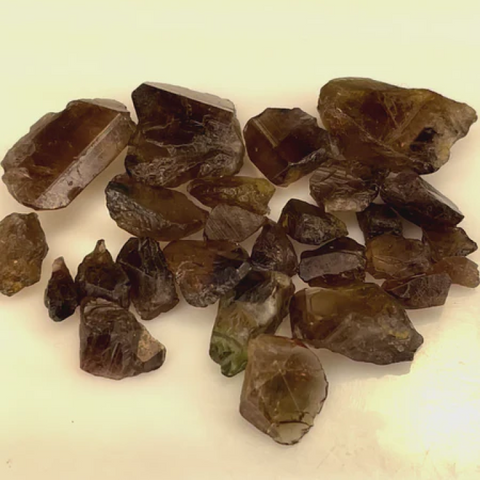What are types of Crystal Structure and how crystals are formed?
Would you like to explore how Crystal Structures are formed? How can one precisely define a natural earthly mined crystals? Understanding this will greatly help you in identifying the natural minerals and gemstones. Each mineral and gemstone possesses a unique crystal structure, characterized by specific arrangements of ions, molecules, and atoms within. It is this precise arrangement and shape of ions and molecules that imparts a distinctive structure to every gemstone and mineral.
Extensive research efforts have been dedicated to gather data for analyzing the crystal structures of minerals. Scientists and researchers have meticulously defined these crystal structures of gemstones and minerals as follows:
- Crystals by Shape or grouped by Lattices
- Recognition of crystals by Properties
Natural Crystals grouped by Lattices
1-The form of crystals or their arrangement within lattices.

In Lattices group of crystals, for identifying the crystals , the researchers have highlighted the 7 different crystalline structures as mentioned below
Browse to Explore Raw Crystals Collection In Person →
-
Tetragonal: This crystal structure bears resemblance to the cubic structure, yet its axes are longer. In the tetragonal system, three axes intersect at 90-degree angles. Despite having a square base, the height of these crystals exceeds the axis length. They commonly form double pyramids and prisms.


-
Cubic or Isometric: They have sometime octahedrons having 8 faces and some times dodecahedrons having 10 faces. Examples are flourite, pyrite. Checkout Cubic crystal structure stones


-
Orthorhombic: These crystals resemble the Tetragonal system but differ in that they do not have a square cross-section. Instead, they form rhombic prisms and dipyramids. Aragonite , topaz is example.

-
Hexagonal: When These crystals will have 6 sided prism and hexagon. Beryl is an example. Other examples are Emeralds. Check out here Hexagonal structured crystals or gemstones


🔮 Explore Real Crystal Structures
See the crystal lattices discussed in this article! From hexagonal sapphires to cubic zircons - discover authentic specimens that showcase these fascinating structures.

-
Trigonal: These have single 3 gold axis of rotation instead 6 fold like hexagonal division.abhurite, alpha-quartz is an example.


-
Triclinic: These crystals do not come in a symmetrical form which leads t strangers shaed. Axinite, kyanite is an example.


-
Monoclinic: Like These crystals usually work prisms and double pyramids. Examples are gypsum, orthoclase, muscovite, clinoamphibole, clinopyroxene, jadeite, azurite, and spodumene .

🔬 Crystal Structures & Physical Traits
Explore how crystal structure influences gem properties. Sourced from GIA, USGS, and scientific literature.
| Crystal Type | Example | Melting Point & Traits | Reference |
|---|---|---|---|
| Covalent Network | Diamond | ~3550 °C, highest hardness | USGS.gov |
| Metallic | Bismuth | High conductivity, lustrous, malleable | MRSEC Wisconsin |
| Ionic | Halite (NaCl) | ~801 °C, brittle, soluble in water | LibreTexts |
| Molecular | Ice (H₂O) | ~0 °C, low hardness, melts easily | CK-12 Foundation |
💎 According to GIA and USGS, understanding crystal types helps identify gemstone properties, durability, and origins. Over 140 million carats of gem-quality diamonds were mined globally in 2023 alone.

Rare Staknala Tourmaline Crystals
Beautiful multicolored tourmaline crystals from the Staknala region.
View Product
Aquamarine Crystal on Mica – Skardu
10.49 grams natural aquamarine crystal with mica matrix from Pakistan.
View ProductCrystals Grouped by Properties
There are 4 different crystal categories according to their chemical and physical properties.
-
Covalent Crystals: A covalent crystal will have strong covalent bond between all atoms. Covalent crystal can be called as a big molecule. Such Crystals are melt on very ugh melting points. Examples are diamond, zircon.

-
Metallic Crystals: This is very interesting. In the crystal structure, metal atoms of crystals lays on lattice sites.outer electrons flour outside the latice. Metallic crystals are dense and also having high melting points. Like Bismuth


-
Ionic Crystals: The atoms of ionic crystals are bound together by ionic bonds. Such crystals are very hard. They also have a high melting points.

- Molecular Crystals: These crystals are held together by non covalent interactions like hydrogen bonding. recognizable molecules within their structures. Such crystals are usually soft and having low melting point. Table sugar is an example.
These data is based on researches made by researchers. There is no definite rule to define crystals. As new Gemstones and minerals appear in different regions with more complex crystal structure. Than new rules are to be decided. However already researched can help us in recognizing gems and minerals.
Read More on Gem Crystals:
Something Interesting about Gems and Minerals
- How to identify gemstones using basic tools
- Tips to identify real and fake amber stone
- Star Phenomena in Sapphires





































0 comments